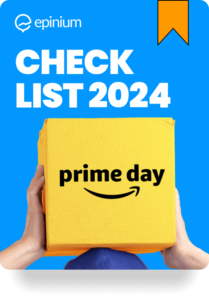If you’re looking to master the positioning of your products on Amazon, you’ve come to the right place. Doing SEO on Amazon is becoming one of the major trends in digital marketing in recent months due to its unique differences from SEO on Google.
Amazon is a marketplace, and its goal is to sell as much as possible, so it prioritizes offering products with the highest chances of generating sales in the top positions. Therefore, the most important metrics for achieving product positioning on the first pages of search results are CTR (Click-Through Rate) and Conversion Rate.
In this article, we will talk about everything you need to know about SEO optimization on Amazon, breaking down every crucial aspect you need to be aware of to increase the visibility of your products, boost your sales, and become an expert on the platform.
What is Amazon SEO?
Amazon SEO involves all the strategies and practices aimed at ensuring that your products appear in the top positions when people search on Amazon. Within this vast Amazon universe, SEO acts as your ticket to achieving a prominent position in search results.
If you implement a strong SEO strategy, you can be confident that your products will appear in the top spots whenever users search for something on Amazon.
For those already familiar with SEO practices on Google, it’s important to note that the focus on Amazon is somewhat different.
How Amazon SEO Works?
Amazon acts as a powerful search engine that displays results based on the entered criteria. Therefore, optimizing SEO on Amazon is essential to increase traffic and, consequently, sales.
The marketplace values management quality, so maintaining well-stocked inventory and minimizing returns are pivotal factors for optimizing Amazon SEO.
Even if all other aspects are well-polished, these fundamentals cannot be overlooked. The terms used in each product listing play a crucial role in the sales process as they determine which products will be shown to potential customers in their searches.
Among the various elements that boost both Click-Through Rate (CTR) and Conversion Rate, which we will explore in detail shortly, one of the crucial secrets to positioning a product under specific search terms lies in the “Search Terms” section. Although this section is not visible to customers and is located on the seller or vendor platform, it is essential for appearing in relevant searches.
1. Amazon Search Box
Customers have the ability to seek out products by entering keywords or phrases into the search bar situated at the apex of Amazon.com’s main page.
Online shoppers can utilize the Amazon search bar to swiftly discover items with a drop-down menu of product categories.
Customers also retain the choice to input broad search terms. Amazon retrieves pertinent outcomes for the entered words or phrases, and the consumer can refine their query to narrow down search results.
2. Search Filters
During their product search, consumers can employ an array of filters to sort search outcomes in a specific sequence, encompassing:
- Category
- Bestselling items (the most favored products based on sales)
- Newly launched or fresh arrivals
- Highlighted merchandise
- User appraisals
- Trending products (items with significant sales rank gains over a 24-hour span)
- Price spectrum (high or low)
- Digital content and devices
- Special programs and features (such as Subscribe & Save, Small & Medium Enterprises, and more)
3. Search Results Page
Variables that can impact search results encompass:
- Product titles
- Product descriptions
- Optimized images
- Product attributes
- Competitive pricing
You can deploy SEO techniques to enhance each of these aspects and elevate your ranking in Amazon’s search results. Delve further into this article for comprehensive insights.
4. Sponsored Products
Sponsored Merchandise entails cost-per-click (CPC) advertisements that sellers can utilize to promote individual product listings within Amazon’s stores, accessible to sellers with a Professional seller account enrolled in Amazon’s Brand Registry.
These advertisements are visible on shopping results pages and on individual product detail pages.
Amazon will automatically formulate and align advertisements with search queries. Sponsored Merchandise can aid in reaching potential buyers actively searching for products akin to the ones you have on offer.
Did you realize?
The Listing Quality Dashboard is a tool within Seller Central that highlights specific product information. This dashboard identifies product listings requiring enhancement and provides suggestions regarding which product attributes should be provided.
5. Amazon Sales Rank
Amazon assigns a rating to all sellers based on various performance metrics, including account health, reviews, product pricing, and other determinants.
In general, the higher your ranking, the greater your selling potential. Gain deeper insights into the mechanics of the sales rank by exploring more.
Why is Amazon SEO Optimization Important?
Working on SEO on Amazon when selling through this marketplace is as important, if not more so, than working on SEO on Google. An effective SEO strategy makes it easier for products on offer to achieve prominent positions in search results.
However, beyond keyword-based strategies, crucial factors related to sales, seller reputation, and user ratings come into play. Achieving a prominent position in search rankings offers significant advantages in product profitability by enhancing its visibility.
This direct impact on sales also extends the overall visibility of the product. The privileged position that every seller seeks in search results is in the hands of Amazon’s A9 algorithm.
It is crucial to understand the factors that influence this algorithm to stand out in the product category on Amazon. Use specialized tools or seek professional assistance to make your store excel on Amazon.
How long does it take to see results?
While each case is unique, in general, it takes time and patience to observe significant improvements in the positioning of your products. Results are not usually immediate since Amazon’s algorithm needs time to analyze and consider the changes you’ve implemented.
In most cases, it can take weeks or even months before you see a noticeable increase in your rankings and visibility. Although it may seem like a slow process, it’s essential to remember that every effort you invest in improving your Amazon SEO has the potential to yield lasting results.
How does the Amazon ranking algorithm work?
Amazon ranks products based on the likelihood that someone will purchase them. But how does the Amazon algorithm know if someone is going to buy a product?
First, Amazon looks at the words a person uses to search. If the search words are not in your product description, your product may not appear in search results.
That’s why using the right words in your description is crucial. Next, Amazon assesses how well your product has performed in the past.
The algorithm considers factors such as:
- How many times people have clicked on your product in search results.
- How many times people have purchased your product after viewing it.
- Overall, how many products you’ve sold.
Your product might be more popular for some searches than others. For example, if someone is looking for a product of a specific color or size, and your product is just what they’re looking for, they are more likely to buy it.
How the Amazon A9 Algorithm Works – The Key to Amazon SEO
Within the Amazon environment, its efficient search engine operates thanks to the A9 Algorithm, which is responsible for directing users to the products they wish to purchase. In Amazon, users want to buy, and Amazon wants to sell, which is why its algorithm’s role is to match the query with a group of relevant products and display these products on a series of pages.
Mastering SEO on Amazon involves considering the factors that affect positioning within the Marketplace’s environment to have your products displayed among the most relevant results for the user’s query.
Although Amazon never fully discloses the details of its algorithm, some conclusions about its operation can be determined. For example, Amazon SEO researchers have observed that:
- Each sale or download of an item contributes to a score.
- This score is halved daily and combined with the points accumulated for the current day.
- Additionally, Amazon ranks products in each category based on recent scores.
How Amazon’s A10 Ranking Algorithm Works
The algorithm Amazon uses to rank products in search results is called A10. Its goal is to determine the most relevant products to display in buyer searches.
Unlike search engine algorithms like Google or Bing, A10 is designed specifically for transactional intent. In other words, Amazon users aren’t looking to learn new information or conduct research; they’re specifically interested in making a purchase.
A10 considers multiple factors when determining how to rank products, including:
- Keywords: Including relevant search terms in your product description signals to Amazon that your product is relevant for a specific search.
- Conversion Rate: Amazon aims to display products with a high conversion rate to buyers. Therefore, a high conversion rate can help your product appear at the top of Amazon search results.
- Reviews: Positive reviews encourage buyers to make a purchase. Having many positive reviews improves conversion rates and, in turn, search results.
- Sales History: A product with a significant sales history is popular for a reason. A prolonged sales history indicates to Amazon that your product deserves prominence among buyers. When someone mentions Amazon’s A9 or A10 algorithm, they’re referring to the criteria Amazon uses to rank products in a specific search on the Amazon search engine results page (SERP). However, internally, Amazon doesn’t seem to use this industry term.
Because of this, Amazon’s algorithm favors products that are more likely to generate sales.
The Benefits of Amazon SEO
Amazon SEO offers many benefits for sellers. By implementing effective SEO strategies, you can enjoy the following advantages:
- Increase Sales and Revenue: By optimizing your product listings with relevant keywords, high-quality images, and compelling descriptions, your business can appear in higher search results, attracting more potential buyers. This translates into higher click-through rates, improved sales, and ultimately, increased revenue.
- Boost Product Visibility and Credibility: The more your potential customers see, hear, and read about you both inside and outside Amazon, the more they consider you a credible business. While the products you offer may be similar to your competitors, customers tend to choose you because of familiarity.
- Help Customers Make Informed Decisions: Thanks to effective keyword optimization and product descriptions, customers can easily find the products they need. They can make informed decisions with readily accessible relevant and accurate product information. This leads to higher customer satisfaction and conversion rates.
- Improve Brand Awareness and Loyalty: By optimizing product listings with relevant keywords and ensuring high visibility in search results, businesses can reach a broader audience, increasing brand exposure. This increased visibility helps build credibility and trust among potential customers, encouraging repeat purchases and long-term loyalty.
- Enhance Competitive Advantage: Amazon SEO helps improve a company’s competitive advantage by increasing visibility and rankings in search results. With higher rankings and more potential customers, businesses can gain an edge in the highly competitive Amazon Marketplace.
- Improve Seller Ranking: With Amazon SEO, your products are more likely to appear at the top of search results, increasing visibility and attracting more traffic to your listings. This can significantly boost sales and revenue, as customers often choose products from better-ranked sellers.
What Factors Does Amazon Consider When Positioning Products?
Keyword Research
Just like with Google, conducting “keyword research” on Amazon is crucial. This will help you appear in searches and increase your chances of making sales. Choosing the right keywords on Amazon makes a difference in how a product is positioned on the platform. Here are some recommendations for selecting the best keywords on Amazon:
-
Think about how customers would search for the product you’re selling.
-
Choose words that are super specific and perfectly match the product you offer. Keep in mind that some words are used by other sellers so much that they no longer have the same impact as before, losing their effectiveness.
-
Consider using “long-tail” keywords, which are combinations of three or more words. Although they have a lower ranking, they are easier to position.
-
Add keywords that have at least 50 monthly searches, although it would be great if they exceeded a thousand.
Once you have your list of noted keywords, it’s time to analyze them with the help of specific keyword tools for Amazon. This will allow you to discover additional keywords that result from the original searches you conducted.
Amazon Listings Optimization
When it comes to selling, product optimization will determine success on Amazon. Optimizing the product involves making the most of all the resources that Amazon provides to ensure that the item appears in the top positions of the sales ranking. Title, attributes, bullets, and description are the four main fields that have a significant influence on proper SEO positioning on Amazon.
Title
We’re talking about the most relevant and important element when it comes to dealing with search results: absolutely all the keywords inserted in the title will be considered in the search.
Assuming you’ve already conducted thorough keyword research and know which keywords are the most relevant to include in your product’s title, you should now determine the best structure for the title.
The order in which keywords appear in the title has no significance for optimization on Amazon. However, it’s essential to take a moment to create the most suitable title for potential customer searches.
It’s best to create a title that closely matches what the potential customer would search for. Amazon provides a style guide for each category to help you understand the title structure that will improve the product’s CTR (Click-Through Rate).
As a general rule, the title should always display the product, the brand, the model, the item count, and a couple of keywords for description.
It’s advisable to also include a reason why the customer should purchase that item rather than the competition, delivering the message positively and in a way that encourages action.
Let’s look at some examples: If we’re talking about Sheets and Blankets, it’s recommended not to exceed 200 characters and start each word with a capital letter, except for articles and prepositions, with the following structure:
{Brand} {Product Type} {{Line/Pattern}} {Thread Count} {Material} {Size}, {Color}
On the other hand, for personal care items, Amazon suggests not exceeding 50 characters with the following structure:
{Brand} {Product Type} {Functionality} {Model Number} {Size/Dimension} {Pack Quantity} {Color} {Scent} {Flavor}
Amazon is very specific in its recommendations to align as closely as possible with what the customer is searching for, increasing the number of clicks as a result.
2. Bullet Points
Customers use this section to quickly get an overview of everything the product offers. You should aim for this section to be compelling enough for the person to decide to purchase the product or, at the very least, capture their attention so they’ll read the rest of the product description.
Amazon allows you to add 5 Bullet Points in a highly privileged position on your product page to enhance conversion. We should not underestimate this descriptive window since it enables the inclusion of additional keywords that are not found in the title.
These bullet points serve as a complement to the keywords we couldn’t include in the title, especially those that resonate with our target audience. This attributes space becomes a platform to persuade buyers with compelling arguments.
To ensure the use of suitable keywords that will help sell on Amazon, it’s essential to consider all the features that make our product unique and attractive to buyers.
It’s crucial to maintain consistency in the order of the various features of your products. For example, if your first Bullet Point is about composition and the second one addresses washing instructions, it’s important to maintain this same sequence for all products in the same category.
Additionally, reiterate the key information from the title and product description in the Bullet Points, and make sure each one begins with a capital letter and does not include a period at the end. Avoid adding details related to offers, prices, shipping, or company information in the Bullet Points, as this is not the appropriate place for them.
Use a numeral format for numbers, and in the case of Bullet Points with more than one sentence, separate them using semicolons. Following these guidelines will contribute to a more organized and effective presentation of your products on Amazon.
The key is to be direct and precise, avoiding unnecessary words. At this point, we can make the most of the additional 200 characters for each attribute to effectively convey the distinctive qualities of our product.
3. Description
The title and attributes alone are not sufficient to encompass the entire essence and particularities of the product being sold. In this context, an effective description becomes the key piece for strategically positioning the item.
Your product description is an addition to the Bullet Points that allows you to explain in much greater detail what benefits your product offers. Don’t limit yourself to describing the product; try to place the product in a situation and context so that the person can envision using it.
Use correct grammar and include details such as weight, color, composition, warranty, size, and materials. By adding the search terms used in the title, we further optimize the result.
Even though the description may be one of the least-read elements, its importance should not be overlooked. Providing comprehensive information about the product is essential for buyers interested in specific attributes.
Furthermore, an optimized description not only increases visibility but also provides the opportunity to use up to two thousand characters to capture the potential customer’s attention.
4. Amazon Search Terms
Amazon’s ingenuity comes into play by combining feed keywords with other components on the page to shape the meta keywords. These keywords remain hidden from users, but Amazon’s search engine analyzes and considers them in the SEO positioning process.
Amazon allocates five lines for the inclusion of this type of keywords. In each line, you can insert from one to a thousand characters, separated by spaces, which amounts to approximately 800 keywords in total.
While filling out this additional space requires extra effort, the result is highly valuable in terms of positioning quality.
Here, you can include the main keywords that describe the product, secondary keywords that indirectly refer to the item, a third category for describing attributes, and finally, a last one for categories.
It’s clear that this task is complex and requires specific knowledge. Therefore, it’s an excellent idea to collaborate with professionals such as a digital marketing agency or use specialized tools.
This will ensure that the work is carried out effectively, contributing to achieving a prominent position in Amazon’s listings, increasing the visibility of your products, and turning your efforts into successful sales.
5. Product Images on Amazon
The visual presentation of a product before purchase is essential for buyers. Product images play a crucial role on Amazon, as they allow the item to be shown from various angles, examine its appearance, size, features, color, and shape.
Products with high-quality images on Amazon tend to have a higher conversion rate because they provide confidence and clarity to the buyer.
Don’t forget to consider the guidelines established by Amazon regarding specific aspects, such as the background type, how to present the product, and the elements allowed or prohibited in the images.
In addition to the main photo that is visible before viewing the product page, Amazon allows you to add 8 more photos of the product. Professional images can enhance the SEO on Amazon for your products due to the improved conversion rate.
It’s essential that the images show what the customer will receive in their home, excluding accessories that are not included. This prevents confusion that could result in returns or negative reviews from customers.
Try to upload high-quality images, with a minimum of 1000 pixels to activate the zoom function for photos. Use clean, white backgrounds that do not distract from the product and aim to have the product occupy 80% of the image area.
Frames, watermarks, and text in the images are not allowed, nor are colored backgrounds, graphics, or product ratings.
6. A+ Content for a Product on Amazon
In addition to everything mentioned earlier, if you have a Vendor account, you can enjoy the opportunity to add Amazon’s A+ Content for free, for the time being.
This type of content plays a fundamental role in improving customer interaction with the products available on the marketplace. In other words, it is an essential tool for influencing purchase decisions and enhancing the brand’s visibility on the platform.
What exactly is this A+ Content and how does it integrate into the Amazon SEO strategy? There are two types of A+ Content you can add:
-
Enhanced Product Description: This description aims to provide additional details about the product’s features and uses. It complements the information presented in the attribute list (bullet points) and the images on the product detail page. In addition to addressing potential customer questions, this proactive approach helps guide their purchasing decisions.
-
Brand Story A+ Content: This type of content informs Amazon buyers about the brand’s or seller’s history. It includes the brand’s values and the product lines it offers, creating a deeper connection between the brand and the customer.
7. Reviews and Ratings
Customer reviews play a crucial role on Amazon, and their influence on sales is undeniable. These reviews, based on real and impartial experiences, provide credibility and guide potential buyers in their purchasing decisions. In fact, according to Amazon, 93% of users check reviews before making a purchase.
To improve the Click-Through Rate (CTR) of products, it’s important to have a sufficient number of verified customer reviews that instill confidence in your target audience among the myriad of products in Amazon’s search results.
How to Get Reviews on Amazon
If you want your products to have reviews on Amazon, there are a few ways to do it. One way is to ask some people to try the product and then share their thoughts. Sometimes, these people can be offered the product at a very low price in exchange for their honest and genuine opinion.
However, apart from this, it’s up to the customers whether they want to provide a review or not. There isn’t much a seller can do to make customers leave reviews, except asking in the shipping package or using other means to communicate with them.
Nevertheless, a seller can influence the quality of reviews by taking the right approach. If your products are good, you ship them carefully, and you resolve issues promptly, customers are likely to leave positive reviews.
How to Handle Negative Reviews on Amazon
A negative review is not good news, but it’s crucial to know how to respond. On Amazon, any rating below three stars is considered negative. If that happens, the seller should respond quickly with a friendly tone, showing willingness and a positive attitude towards other potential buyers.
It’s not advisable to start disputes but to offer prompt solutions to reverse the negative review. An unanswered negative review can harm the seller’s reputation with other customers.
Furthermore, by not responding, you miss the opportunity to counteract the negative image that a dissatisfied customer might convey.
8. Best Seller Rank – Product Performance Measurement
This ranking reflects the level of quality that Amazon assigns to your product in relation to others in the same category. It is established by considering various factors, such as the sales it generates, user preference, and positive reviews it receives compared to similar products.
To better understand it, it shows how your product ranks in terms of sales compared to other items in the same category.
All the aspects discussed so far are fundamental to stand out and improve your position in the ranking.
9. Categorization on Amazon
In Amazon, a category represents the market niche to which the product you want to sell will belong. These categories are used to classify items for sale, making it easier for potential customers to search.
Furthermore, there are more specific subcategories derived from the main ones, allowing for a more precise search for products within the Amazon marketplace.
The choice of categories and subcategories has a significant impact on the correct positioning of a product for sale. Therefore, it’s crucial to select the appropriate category to find the most profitable niche for your item.
If you are a new seller on Amazon, you may not want to opt for categories with high competition, as you would be competing with experienced sellers who already have numerous reviews and positive ratings.
A new seller aims to position themselves in the top search results to increase visibility and drive sales. For this reason, it is advisable to choose categories and subcategories with lower competition, which will allow you to achieve prominent positions in a shorter period and with greater ease.
10. Product Bundling
The mother-child product strategy involves offering a single item with various variants, providing benefits in terms of visibility and efficiency. Essentially, you have a “parent listing” representing the product itself, and multiple “child listings” containing different options in terms of colors, sizes, and so on.
These child listings are presented as variations of the parent, which allows you to attract customers to a single product page. This strategy has multiple advantages.
First, you increase your value in the eyes of Amazon by boosting traffic and sales. Additionally, all reviews are concentrated on a single product, strengthening buyer trust.
On the other hand, you simplify the optimization and monitoring process since you only need to focus on positioning and tracking a single entry instead of each variant separately.
11. Questions and Answers
Although Amazon has not explicitly confirmed their influence on metrics, the questions and answers sections are located near the product page.
Furthermore, Amazon encourages buyers to answer questions from other users. Where they do have a noticeable impact is on conversions.
Maintain an active interaction with users by providing quick and accurate answers to their questions. This will help improve the customer experience and encourage purchasing decisions.
Amazon Brand Store – Your Dedicated Space
Amazon Marketing Services allows brands to create a customized landing page to enhance their Amazon SEO.
These pages enable sellers to showcase their store and products with careful design, even adapting it to the look of their website. They offer the option to include details that cannot be communicated in the product listing, such as selling points and links to social media.
Through Amazon Analytics, sellers can access detailed metrics to improve their strategy and goals, directing effective communications that enhance their presence and sales on Amazon.
Undoubtedly, an exceptional support to strengthen Amazon SEO through keywords.
Tools for SEO on Amazon
There are valuable tools to position your products with good SEO on Amazon. One of them is Epinium. Its operation is simple: you access your brand panel where all your products are displayed, and with just one click, you can fully optimize your product listings with the best keywords suggested from advertising campaigns. You can even make massive optimizations in your catalog, all thanks to artificial intelligence.
This tool also provides optimization of listings by countries, achieving perfect ad copy automatically in a matter of seconds for any language. The algorithm generates titles, bullet points, and descriptions in any language optimized with the keywords that customers are searching for in each market. Because translating is not the same as optimizing!
Another option offered by this tool is constant SEO auditing. Epinium scans all your ASINs and detects SEO improvements so you can increase your organic visibility and consequently, your sales. It is based on Amazon’s “Retail Readiness” criteria.
Once done, it provides you with a simple, intuitive, and effective control panel for visually identifying areas to improve.
Detecting unpublished changes on Amazon is another feature where Epinium has an advantage over other tools. Many Sellers and Vendors don’t realize that a listing change has been rejected by Amazon until they accidentally return to the product page.
Epinium detects changes in titles, bullet points, descriptions, and search terms that Amazon has rejected, allowing you to re-upload them or open a joint incident.
Regardless of the tool you choose, remember that having a well-optimized SEO for your listings will give you the opportunity to appear first to a customer who is in the final stage of the buying process and ready to purchase a product.
How to Improve SEO on Amazon: Tips & Best Practices
Optimize your Amazon listings in 10 steps
Consider SEO as an ongoing process to connect with Amazon’s 300 million customers. Start by integrating optimization as a continuous part of your e-commerce strategy. Additionally, you can focus your efforts on seven key aspects of the product listing:
Step 1: Keyword Research
- Create a comprehensive list of relevant keywords.
- Consider both long and short keywords.
- Use Amazon’s autocomplete feature to discover popular keywords.
Step 2: Optimize the Product Title
- Ensure the title reflects the product packaging.
- Keep the title concise, between 60 and 80 characters.
- Avoid excessive capitalization and start with the brand.
Step 3: Optimize Product Descriptions
- Include details such as brand, size, and color.
- Highlight important features.
- Follow product quality and condition policies.
Step 4: Optimize Key Features
- Highlight up to five key features.
- Keep descriptions concise, totaling no more than 1,000 characters.
Step 5: Optimize Product Images
- Use high-quality images with multiple perspectives.
- Ensure images have a white background and occupy at least 85% of the space.
Step 6: Optimize Backend Keywords
- Add relevant keywords in the backend of your listing to improve visibility.
- Use relevant synonyms and abbreviations.
Step 7: Optimize Product Price
- Research the competition and adjust your prices to remain competitive.
- Consider offering free shipping.
Step 8: Use A+ Content
- Enhance your listings with A+ content to stand out and increase conversions.
Step 9: Experiment with A/B Testing
- Conduct A/B tests on different product elements to determine what works best.
Step 10: Monitor and Adapt
- Regularly analyze your listing’s performance.
- Adapt your strategy based on data and feedback.
Common Amazon SEO Mistakes to Avoid
As we near the end of this Amazon SEO guide, you now have the knowledge to analyze the A10 search engine and optimize your product listings. However, businesses often overlook other aspects of the Amazon process. These aspects may seem insignificant at first glance but can eventually have a negative impact on a business’s sales performance on Amazon. Here are some of the most common mistakes made by Amazon entrepreneurs in their SEO strategy:
- Inventory Mismanagement: Ensure you manage your product quantity effectively. Not having enough or having too much stock can lead to customer problems.
- Neglecting Your Keywords: Using keywords in your strategy once is not enough. You must keep them up to date and monitor how they perform to continually improve.
- Failure to Understand Amazon’s Changes: Amazon’s search engine changes periodically. If you don’t stay updated on these changes, your strategy could become outdated.
- Not Analyzing Your Competitors: Observing what your competitors are doing on Amazon can help you find opportunities to stand out and improve your listings.
- Providing Incorrect Information: Sharing false information in your listings will only harm your reputation and could get you into trouble. Stay honest with the information you provide.
15 Ways to Improve Your Amazon Listing’s Ranking
- Keyword Research: Utilize tools like Epinium to discover relevant keywords for your Amazon listings and fine-tune your keyword strategy.
- Optimize Product Title: Craft clear and descriptive titles following Amazon’s guidelines, including the brand, description, and other vital attributes.
- Enhance Product Bullets: Showcase the top five product features in the bullet points, using initial capitalization and avoiding promotional information.
- Optimize Product Description: Write detailed descriptions, adhering to Amazon’s rules, and focus on dimensions, care instructions, and warranties.
- Backend Keywords: Employ relevant keywords in the backend keyword section of your listing to enhance visibility.
- High-Quality Images: Ensure high-resolution and professional images, following Amazon’s guidelines.
- Competitive Pricing: Set competitive prices to increase your chances of winning the Amazon Buy Box.
- Maintain Positive Reviews: Encourage positive customer reviews by complying with Amazon’s review guidelines.
- Utilize Fulfillment by Amazon (FBA): Leverage Amazon’s FBA program to streamline the fulfillment process and offer additional advantages.
- Implement Amazon A+ Content: If you’re a registered brand, use Enhanced Brand Content (EBC) or A+ Content to enhance the quality of your listing.
- Avoid Keyword Stuffing: Refrain from overloading your product title with excessive keywords, as it can harm your ranking rather than improving it.
- Strategic Offers and Discounts: Utilize strategic offers and discounts to attract more buyers and enhance your visibility.
- Swift Response to Customer Queries: Respond promptly to customer questions on your product page to improve customer satisfaction.
- Competitor Monitoring: Keep an eye on your competitors and adjust your strategy accordingly to stay competitive.
- Regular Updates: Make frequent updates to your listings to reflect changes in the market and customer preferences.
5 Amazon SEO Tips to Create Compelling Amazon Product Listings
- Avoid Keyword Repetition: Refrain from using the same keywords repeatedly in your listings, as it may come across as spam and not benefit your ranking.
- Customer-Centric Approach: Write sales content with the customer in mind, highlighting benefits and features that interest them.
- Enhance Your Rankings: Work on improving your rankings through effective SEO tactics. This will increase your visibility on Amazon.
- Follow Basic Listing Styles: Ensure you follow basic style guidelines in your listings, including proper capitalization, using numbers instead of words, and avoiding excessive promotional content.
- Download the Quick Style Guide for Amazon Sellers: Access the Quick Style Guide for Amazon Sellers to get more tips on enhancing your listings and sales strategies on the platform.
Tracking and Measuring Amazon SEO Performance
If you’re optimizing your list and working on Amazon SEO, it’s essential to know how it’s performing. You can do this manually by searching for your product using a specific formula in Amazon’s search bar. However, this can be tedious. The more practical option is to use a tool like Epinium, which automatically tracks your product’s ranking and your competitors, saving you time and helping you refine your keyword strategy.
SEO Audits and Buy Box Monitoring
Epinium not only assists you in keyword research and advertising but also conducts comprehensive SEO audits of your Amazon account. It detects and presents all areas for improvement in an intuitive dashboard, allowing you to easily address each error and optimize your strategies.
Additionally, Epinium recognizes the importance of the “Buy Box” in Amazon SEO. Its monitoring tool alerts you if you lose the Buy Box, a crucial aspect for maintaining high performance on the platform.
AI-Powered Keyword Research
One of the most critical aspects of Amazon SEO is selecting the right keywords.
Epinium simplifies and enhances this process through artificial intelligence. This feature enables you to find relevant and highly effective keywords for your niche market, improving the visibility of your products and optimizing your listings with surgical precision.
Amazon Advertising Automation with AI
Advertising on Amazon is an essential strategy for increasing sales. Epinium goes a step further by providing you with the ability to automate your Amazon Ads campaigns with AI.
This feature ensures that your advertising investment is used efficiently, maximizing your return on investment and reaching the right audience at the right time.
Avoiding these mistakes will help you succeed on Amazon and continually improve your SEO strategies. Save time in this process with our platform where Amazon sellers can save 60% time optimizing product detail pages, be 50% more effective following Amazon’s Style Guides and increase their sales by 30%. Get a free audit and start optimizing your listings now! Take advantage of it.








Darío González